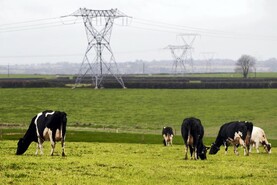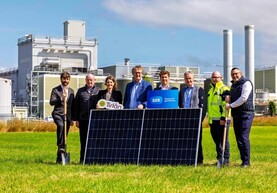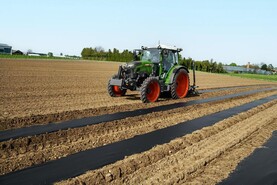Despite ultimately leading to cost savings, investing in solar PV still requires significant capital, which needs to be weighed against other key investments on your farm.
However, with beef and dairy prices strong, and farmers likely in a position to invest again this year, the industry expects that interest in the TAMS Solar Capital Investment Scheme to be strong in 2025.
The scheme allows farmers to avail of a 60% grant towards the cost of a solar PV system and, as electricity prices are set to remain high, payback times for solar remain low.
However, some farmers are complaining that the solar TAMS application is rigorous, and that their applications are queried delaying the approval process.
While still considered a new scheme by some, many of the issues commonly experienced can now be easily worked out. Most farmers are now working with their advisors/consultants or through solar suppliers for TAMS applications.
Figures from the Department of Agriculture show that from tranche 3-5, 1,484 applications were made for solar panel grants under the scheme. Of that, 72 were rejected, 825 were approved and 570 are still in progress.
Requirements
The scheme is designed to allow farmers to secure a 60% grant on solar PV systems which match their farms energy use, and up to 50% of the cost of batteries. Farm houses are also included as long as they are on the same electricity meter.

Solar panels on farm building.
An on-farm solar PV survey must be submitted with the application, showing how the solar PV system which you are applying for matches your farm electricity use.
You will now have to submit actual electricity bills to prove this.
Some other areas which farmers are typically queried on is on maps and drawings. As with any fixed TAMS investment, copies of drawings, farmyard layout plan and site location map identifying location for proposed investment must be submitted with the application. Clarification on any of the drawings may be sought.
In some cases, there may be proof of planning permission, or a planning exemption, required for the solar system.
This will likely only be required in the case that a ground mounted system exceeds 25m² or if the farmer is installing a large rooftop system on a shed in a solar safeguard zone close to an airport. Planning permission is not required the vast majority of cases.
Grid connections
While not directly related to the TAMS application process, many farmers choose to wait until they have TAMS approval before starting the grid connection process. Any system above 6kW on single phase or 11kW on three phase requires an NC7 application with the ESB.
This process can be lengthy, often taking several months to complete. As a result, farmers can find themselves tight against the 12-month deadline to complete an approved TAMS solar investment, or even exceeding it—potentially missing the deadline or having to apply for an extension, which can be difficult to secure.
Claim
The Department issued a clarification last year regarding the requirements for making a claim.
To submit a valid claim, the receipt and certificates must reflect what the applicant(s) actually purchased, installed, or built—regardless of what was originally approved or indicated by the solar survey.
The number and rating of panels installed must be specified, and the system output data on CERT 22 and 23 must match the figures shown on the receipt. The name and address on the receipt must correspond with those on the approval letter.
If both panels and batteries were installed, the receipt must clearly separate the costs into two categories: one for the solar array and one for the batteries.
The invoice must be both paid and marked as such before submission.
If the farmer was approved for, and installed, batteries, they must be included in the payment claim.
Batteries will be funded at a maximum of 50% of the claimed or approved solar panel array size.
Despite ultimately leading to cost savings, investing in solar PV still requires significant capital, which needs to be weighed against other key investments on your farm.
However, with beef and dairy prices strong, and farmers likely in a position to invest again this year, the industry expects that interest in the TAMS Solar Capital Investment Scheme to be strong in 2025.
The scheme allows farmers to avail of a 60% grant towards the cost of a solar PV system and, as electricity prices are set to remain high, payback times for solar remain low.
However, some farmers are complaining that the solar TAMS application is rigorous, and that their applications are queried delaying the approval process.
While still considered a new scheme by some, many of the issues commonly experienced can now be easily worked out. Most farmers are now working with their advisors/consultants or through solar suppliers for TAMS applications.
Figures from the Department of Agriculture show that from tranche 3-5, 1,484 applications were made for solar panel grants under the scheme. Of that, 72 were rejected, 825 were approved and 570 are still in progress.
Requirements
The scheme is designed to allow farmers to secure a 60% grant on solar PV systems which match their farms energy use, and up to 50% of the cost of batteries. Farm houses are also included as long as they are on the same electricity meter.

Solar panels on farm building.
An on-farm solar PV survey must be submitted with the application, showing how the solar PV system which you are applying for matches your farm electricity use.
You will now have to submit actual electricity bills to prove this.
Some other areas which farmers are typically queried on is on maps and drawings. As with any fixed TAMS investment, copies of drawings, farmyard layout plan and site location map identifying location for proposed investment must be submitted with the application. Clarification on any of the drawings may be sought.
In some cases, there may be proof of planning permission, or a planning exemption, required for the solar system.
This will likely only be required in the case that a ground mounted system exceeds 25m² or if the farmer is installing a large rooftop system on a shed in a solar safeguard zone close to an airport. Planning permission is not required the vast majority of cases.
Grid connections
While not directly related to the TAMS application process, many farmers choose to wait until they have TAMS approval before starting the grid connection process. Any system above 6kW on single phase or 11kW on three phase requires an NC7 application with the ESB.
This process can be lengthy, often taking several months to complete. As a result, farmers can find themselves tight against the 12-month deadline to complete an approved TAMS solar investment, or even exceeding it—potentially missing the deadline or having to apply for an extension, which can be difficult to secure.
Claim
The Department issued a clarification last year regarding the requirements for making a claim.
To submit a valid claim, the receipt and certificates must reflect what the applicant(s) actually purchased, installed, or built—regardless of what was originally approved or indicated by the solar survey.
The number and rating of panels installed must be specified, and the system output data on CERT 22 and 23 must match the figures shown on the receipt. The name and address on the receipt must correspond with those on the approval letter.
If both panels and batteries were installed, the receipt must clearly separate the costs into two categories: one for the solar array and one for the batteries.
The invoice must be both paid and marked as such before submission.
If the farmer was approved for, and installed, batteries, they must be included in the payment claim.
Batteries will be funded at a maximum of 50% of the claimed or approved solar panel array size.







 This is a subscriber-only article
This is a subscriber-only article










SHARING OPTIONS: